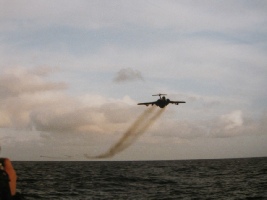The Buccaneer Detachment Commander (Det Cdr) decided to establish an ASOC within the AHQ at Episkopi and man it himself, becoming what the Royal Navy call a “Long Day man!”. This would leave the senior detachment Flight Commander, in charge of the flying crews and aircraft at Akrotiri, responsible for the effective leadership of that part of the operation. The ASOC was established within the Episkopi Air Operations Centre by the Buccaneer dispersal at Akrotiri commandeering two of the desks and designating them ‘Buccaneer Operations.’
The Buccaneer Det Cdr obtained a dusty copy of ATP27 (Manual of Tactical Air Ops) from the publications library and added it to the equipment on the desks. The communicators quickly installed an HF radio facility within the console and two separate networks were established, one embracing the more important units of CTF60 and the other a direct link to COMBRITFORLEB. In concert with the staff at Episkopi, the fighter controllers at Troodos devised a Communications Plan that would deal with all phases of any sortie likely to be flown by the Buccaneers, that is to say: departing Cyprus, transiting through CTF60’s airspace, overflying the FAC in Beirut and re-
One of the detachment’s Flight Commanders (‘Dutch’ Holland) possessed the requisite experience and skill to be the Air Liaison Officer so he was initially despatched to the Iwo Jima, although he was soon transferred to the Eisenhower where he could exercise more influence. To take his place at Akrotiri, a Buccaneer navigator (Norman Browne), an overland Pavespike designation expert, was urgently flown in from RAF Germany. By now, the detachment was confident that it could mount ROE 1-
(‘Dutch’ Holland) possessed the requisite experience and skill to be the Air Liaison Officer so he was initially despatched to the Iwo Jima, although he was soon transferred to the Eisenhower where he could exercise more influence. To take his place at Akrotiri, a Buccaneer navigator (Norman Browne), an overland Pavespike designation expert, was urgently flown in from RAF Germany. By now, the detachment was confident that it could mount ROE 1-
The major problem with the showing-



Op PULSATOR -






